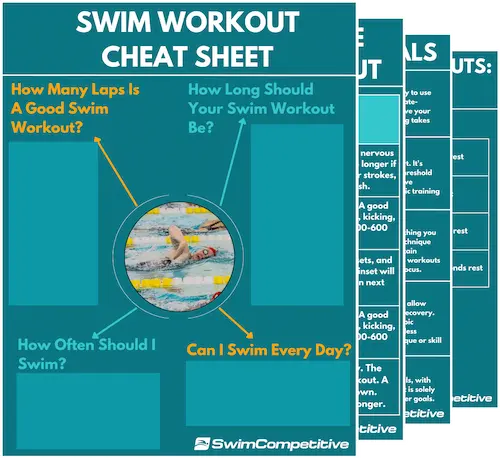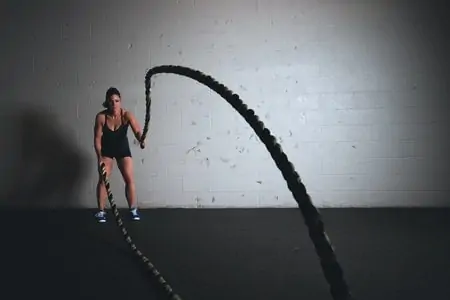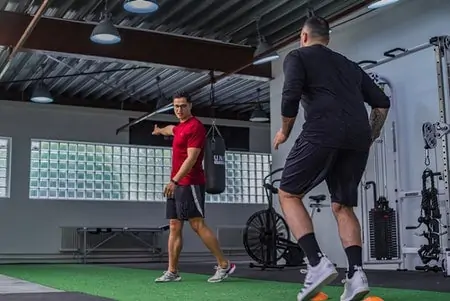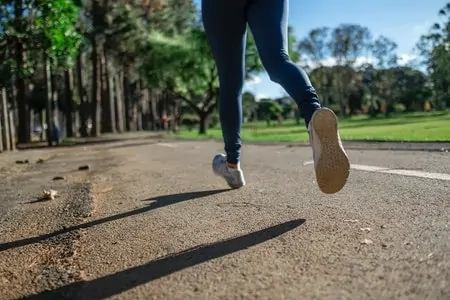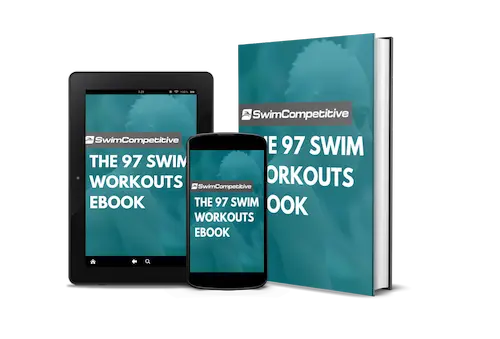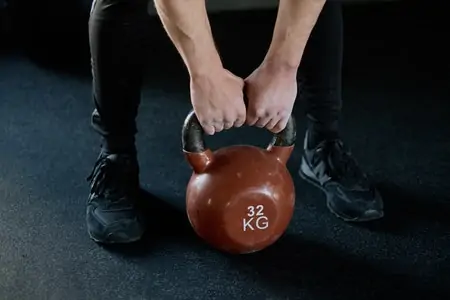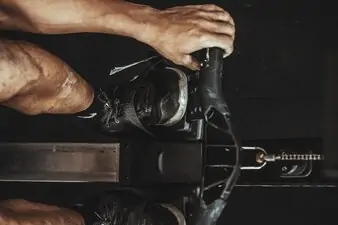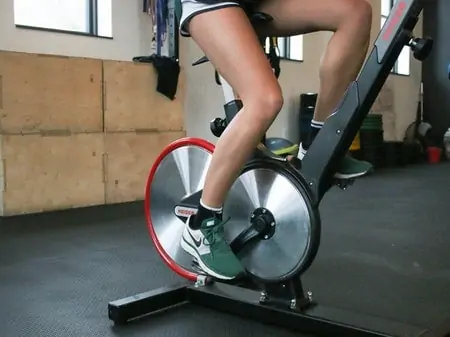Swimming is well known as being one of the best cardio workouts out there. That said, many competitive swimmers still incorporate dryland cardio into their training schedule to improve their endurance and overall performance in the water.
One of the main benefits of adding additional dryland cardio to your swimming training schedule is the fact that you’ll utilize certain muscles more than you would in swimming which will help to increase endurance and strength in those muscles leading to better swimming performance in the pool.
That’s why in today’s article we’ll be having a look at some of the best dryland cardio workouts swimmers can incorporate into their training schedule to improve their performance. We’ll discuss the benefits of each and how often you should be doing additional cardio on top of your swim training.
Dryland Cardio for Swimmers- 7 Top Workouts
Here are some good dryland cardio workouts for swimmers-
- Jump Rope
- High Intensity Interval Training
- Plyometrics
- Running
- Kettlebell Training
- Rowing
- Cycling
1. Jump Rope
Jump rope is notoriously popular among boxers, but might as well be among swimmers too. Jumping rope is a simple dryland cardio workout which is great for improving foot speed, agility, coordination, and shoulder strength, all while burning a ton of calories.
Another huge bonus of this dryland cardio workout is the fact that it’s straightforward, cheap, and easily accessible. You don’t need a lot of space to jump rope and it can be done practically anywhere.
Personally, I like to do some jump rope before getting in the water to help warm up and activate my muscles. Something as simple as 5 minutes of jumping rope is a great way to warm up the body and ensure that you don’t get injured in the pool.
An additional benefit of jumping rope is the fact that this is very low impact on the body, similar to swimming. Jumping rope doesn’t place a lot of stress on the joints and is easy to recover from after a workout.
If you want to incorporate this into your training regimen as a dryland cardio workout I recommend doing interval jumping, similar to interval training in the pool. Do 1-2 minutes of continuous skipping and then rest 30 seconds. Repeat this for 8-15 rounds to get a very solid workout in, in only about 30-45 minutes.
If you are in need of a jump rope, I recommend using a slightly heavier rope.
Want to learn more about jumping rope for swimmers? Click here to read our article on it.
2. High-Intensity Interval Training (HIIT)
Many swimmers are familiar with circuit styled dryland workouts. High Intensity Interval Training, also commonly known as HIIT is very similar and is one of the most effective ways to increase your cardiovascular fitness as well as strength. Another benefit? It’s highly time effective as well.
The main difference between HIIT and traditional circuit styled dryland workouts is timing. HIIT workouts are based on grouping a set of exercises together (usually 4 or 5) while focusing on speed and completing each exercise on a set interval before moving to the next. Short rest periods between exercises are also incorporated.
This style of workout burns a lot of calories while also increasing endurance, speed, and strength- all of which are important for becoming a better swimmer. Basic equipment such as dumbells, medicine balls, or kettlebells can be used, but aren’t necessary.
Here are 2 example HIIT Workouts for swimmers.
Example 1-
- High Knees.
- Butt Kicks.
- Bodyweight Squats.
- Explosive Push-Ups.
- Crunches.
Example 2-
- Jump Rope.
- Mountain Climbers.
- Burpees.
- Jumping Jacks.
- Sit-Ups.
Instructions: Repeat each exercise for a period of 1 minute, with 20-30 seconds rest in between. Do 5 Rounds in total. 1-2 Minutes rest between rounds.
Time: 45 Minutes For Entire Workout.
If you can’t quite do each exercise for 1 minute at a time, trim it down to say 30 or 45 seconds and work your way up from there.
Related: Leg exercises for swimmers.
3. Plyometric Training
Plyometric training is a style of workout designed to develop speed, agility, and strength by utilizing high energy jumping and accelerated movements. These jumping style movements are very important for swimmers as they can contribute significantly to faster swimming times in the pool by improving your starts, turns, and push-offs.
Plyometrics generally isn’t as much as a cardio workout as jumping rope or HIIT. That said, you can very easily also turn this into an interval-based circuit workout, similar to HIIT which will be highly effective for cardiovascular fitness, strength, and increased jumping capabilities.
Caeleb Dressel, one of the fastest swimmers in the world with world-records in multiple events, is a good example of why swimmers should incorporate plyometric training. Caeleb has a vertical jump of 41 inches- the result? He has by far one of the best starts in the world coming up half a body length to a full body length ahead of the competition on every race.
Here’s a little video of that-
Here is an example plyometrics workout-
- Jump Rope
- Jumping Bodyweight Squats
- Burpees
- Lunge Jumps
- Clap Push Ups
Instructions: Repeat each exercise for 10-30 reps, rest 20 seconds. Do 8-10 rounds in total.
Time: 30-45 minutes.
As you can see this workout is based more on reps rather than intervals. Rest is relatively low which means you’ll very quickly get your heart rate up helping to work on the cardiovascular side of things. These dryland exercises will also help you to build added strength, especially in your legs.
Related: Swimming And Weight Training.
4. Running
Running is probably one of the simplest and most basic dryland cardio workouts that swimmers can do. It requires very minimal equipment and can be done almost anywhere, granted you have enough space.
Running can be broken down into 2 main categories- namely jogging and sprinting. Jogging refers to running at a controlled, moderate pace usually over a longer distance of say a few miles for example.
Sprinting, on the other hand, refers to running as fast as you can for short periods of time over a far shorter distance.
Both are very effective as a dryland cardio workout but do work different aspects. Jogging is more focused on the endurance side of things while sprinting is great for developing fast twitch muscle fibers.
To get the best of both worlds you can combine the two. For example, you can jog for a couple of hundred yards, then do a 50-100 yard sprint as fast as you can whereafter you then jog again a few hundred yards before sprinting again. Repeat this over a 2-3 mile distance.
Related: Weight Lifting For Endurance Swimmers.
Do You Want to Make Every Lap Count?
Stop wasting your time in the pool feeling lost and doing directionless swim workouts, and start training effectively! Our ebook contains 97 structured and goal-orientated swim workouts to help you become a better, faster, and fitter swimmer. Whether you’re a complete beginner or a seasoned pro, there are a multitude of workouts for every type of swimmer.
5. Kettlebell Training
A little on the more advanced side of things is kettlebell training. This dryland workout isn’t exactly a cardio-only workout, but rather combines the best of both worlds, namely strength, and cardio.
With many cardio workouts, you aren’t going to be building a lot of muscle, kettlebells are, however, an exception to this as the added resistance on your muscles while doing this style of workout will create micro-tears in the fibers, causing the muscle to grow as well.
Similar to many of the workouts we have covered so far, kettlebell training is also best applicable as a circuit style of workout. Pick a few kettlebell exercises and perform each movement for 30-40 seconds, then rest for 20-30 seconds and move onto the next exercise.
You can do a set number of rounds or set your timer for 30-45 minutes and see how many rounds you can complete. Then next time, you can aim to do more rounds in the same space of time to ensure progression.
Here are some good kettlebell exercises–
- Kettlebell Swing
- Kettlebell Sumo Squat
- Kettlebell Lunge
- Kettlebell Row
- Kettlebell Russian Twist
- Kettlebell Goblet Squat
The key is not to go too light, but not to go too heavy either. Pick a moderate weight which is both comfortable to move around and challenges you.
Related: 7 Best Arm Exercises For Faster Swimming.
6. Rowing
Rowing is a great dryland workout which engages both the upper and lower body. This style of dryland workout is also quite low impact on the body which is great since you don’t want to be taxing your body too much outside of the pool in order to still ensure optimal performance in the water.
Rowing is a very effective cardio workout which burns a lot of calories and builds some great endurance. This workout is especially good for developing a strong posterior chain which is highly beneficial for swimmers as the back muscles are frequently utilized. This will also encourage good posture, which is unfortunately something many swimmers struggle with.
The only downside to rowing, compared to the other styles of dryland workouts we’ve discussed so far is the equipment. Rowing machines are definitely on the expensive side of things and you’ll most likely have to take the time to head out to the gym if you want to incorporate this style of workout into your training schedule.
That said, if you do want to pick up a rowing machine to add to your home gym gear consider checking out this nice one:
Related: Why Every Swimmer Should Do Pull Ups.
7. Cycling
The final cardio workout on our list is cycling. Similar to rowing this style of dryland workout is going to require you to either have access to a gym, your own stationary bike, or an actual bike you can use on the road.
Cycling is very effective for building endurance and cardiovascular fitness while also being low impact on your body. This style of dryland cardio will especially be useful for developing a stronger kick in the pool as cycling is obviously very leg-intensive.
Quick fact- did you know the kick is able to generate upwards of 31% of propulsion in a 30s fully-tethered freestyle sprint? These numbers are from a study published in the BioMed Research Journal. Now that’s a lot of power right there in your legs! Keep in mind other strokes, such as breaststroke, will most likely see even bigger percentages, and so will longer distance events as well.
While purchasing your own road bike can be expensive, stationary bikes are actually quite affordable while being just as effective.
Related: Resistance Band Strength Exercises For Swimmers.
How Often Should Swimmers Do Dryland Cardio?
Generally, swimming in itself is already a great dryland cardio workout which will develop excellent fitness, strength, and endurance. It is also, obviously, the most effective way at actually getting better at swimming itself.
That said, incorporating additional dryland cardio workouts holds many benefits for swimmers as discussed throughout this article.
As a general guideline, swimmers can do dryland cardio roughly 2-3 times per week on top of their current swim training, provided that they aren’t swimming doubles. This should allow for extra endurance and strength while still allowing your body adequate time to recover between workouts.
If you do incorporate dryland cardio to your training schedule, make sure to do it on your off days from the pool or to give yourself a few hours between your swim workout to allow your body a bit of time to rest. For example, if you are swimming in the afternoons consider doing your dryland cardio first thing in the morning.
Make Sure to Always Warm Up Properly Before Dryland Training
It is very important to always warm up properly before doing any style of exercise. Whether that be dryland cardio, swimming, or lifting weights. Make sure to take 5-10 minutes to do some dynamic stretching, foam rolling, and light exercises such as resistance band activation exercises to get the blood flowing before starting your workout.
This will ensure that you not only avoid injury but also perform optimally during your workout which will ensure maximal progress in the pool.
Improve Your Swimming Endurance with Dryland Cardio
I highly recommend swimmers to incorporate additional dryland workouts into their training regimen. This will help swimmers to develop extra endurance and strength while also lowering the risk of injury by strengthening the muscles in their bodies.
